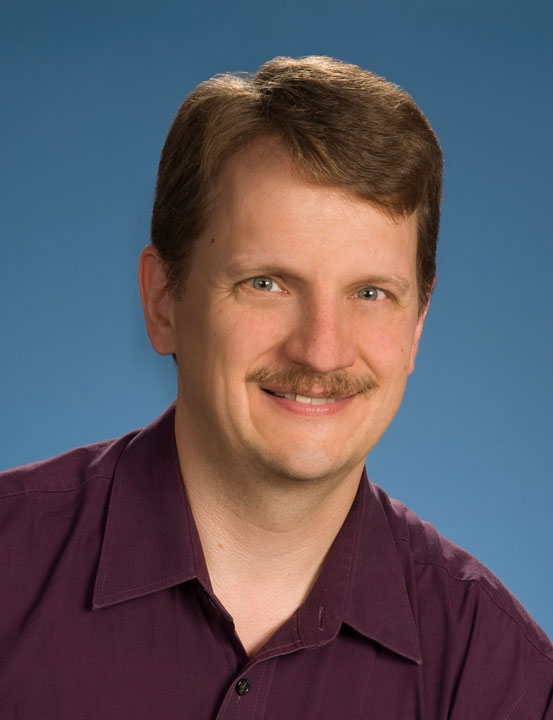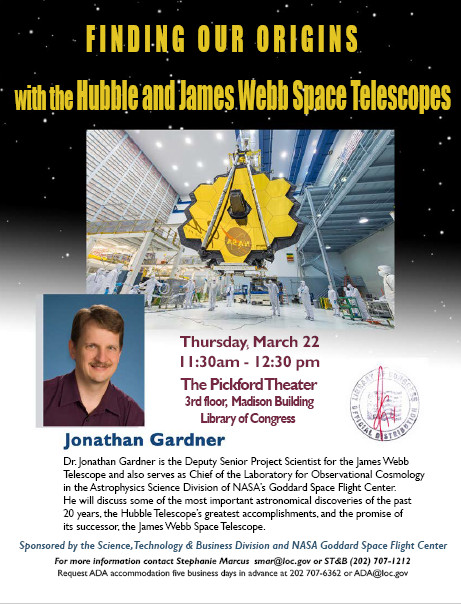The public is invited to a free talk called “Finding Our Origins with the Hubble and James Webb Space Telescopes,” with Dr. Jonathan Gardner in the Pickford Theater, third floor, Madison Building, Library of Congress, Washington, D.C., on March 22 from 11:30 a.m. to 12:30 p.m. EDT.
Gardner is the first speaker in the 2018 NASA Goddard Lectures Series at the Library of Congress. Gardner is deputy senior project scientist for the James Webb Space Telescope at NASA’s Goddard Space Flight Center in Greenbelt, Maryland. He will discuss some of the most important astronomical discoveries of the last 20 years, the Hubble Telescope’s greatest accomplishments, and the promise of its successor, the James Webb Space Telescope.

Gardner has worked on the Webb telescope project since the late 1990s. Gardner was an undergraduate student intern at NASA working on a camera for the Spitzer telescope, and after graduate school in Hawaii and a fellowship in England, he joined NASA in 1996 to work on a camera for Hubble. While Gardner’s main interest is how galaxies formed and evolved, as chief of the Cosmology Lab, he works with scientists who study the universe as a whole.
Hubble, the first large space-based optical telescope, has been circling Earth and making observations for nearly 28 years since its launch in April 1990. Hubble recently had its eye on a relic galaxy, NGC 1277, the first such galaxy to be found “nearby” (240 million light-years away from Earth). Its stars were born 10 billion years ago, but it has undergone no further star formation. Such galaxies are called “red and dead,” but most have been too far away to be studied. This galaxy is giving scientists a closer look and is unique in that it is a relic of what galaxies were like in the early universe.
NASA’s James Webb Space Telescope will allow astronomers to measure the motions of the globular clusters in NGC 1277, and this will provide the first opportunity to measure how much dark matter the primordial galaxy contains.
The Library of Congress maintains one of the largest and most diverse collections of scientific and technical information in the world. The Science, Technology and Business Division provides reference and bibliographic services and develops the general collections of the library in all areas of science, technology, business and economics.
The Library of Congress is the nation’s oldest federal cultural institution and the largest library in the world and holds nearly 151.8 million items in various languages, disciplines and formats. The library serves Congress and the nation both on-site in its reading rooms on Capitol Hill and through its award-winning website.
For inquiries about this or upcoming talks at the Library of Congress, the public can contact the library’s Science, Technology and Business Division at 202-707-5664. ADA accommodations should be requested five business days in advance at 202-707-6382 (voice/tty) or ada@loc.gov.

The lecture will be later broadcast on the library’s webcast page and YouTube channel “Topics in Science” playlist.
For more information contact Stephanie Marcus at 202-707-1212 or smar@loc.gov or visit: http://blogs.loc.gov/inside_adams/
For directions, visit: http://www.loc.gov/visit/maps-and-floor-plans/
For more information about the Webb, visit: www.nasa.gov/webb
For more information about the Hubble, visit: www.nasa.gov/hubble
Rob Gutro / Lora Bleacher
NASA’s Goddard Space Flight Center, Greenbelt, Md.
301-286-0697 / 2009
Robert.j.gutro@nasa.gov / Lora.v.bleacher@nasa.gov

























